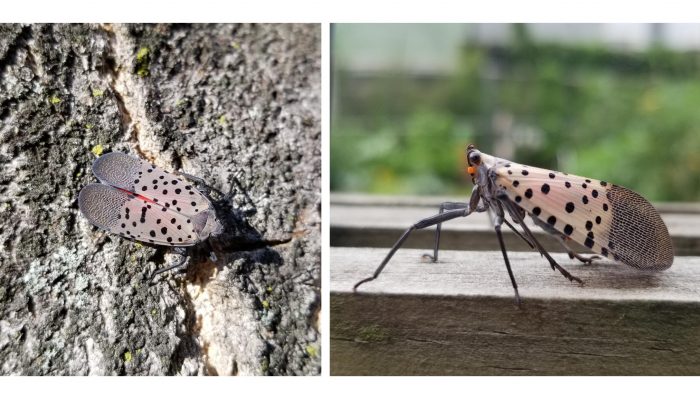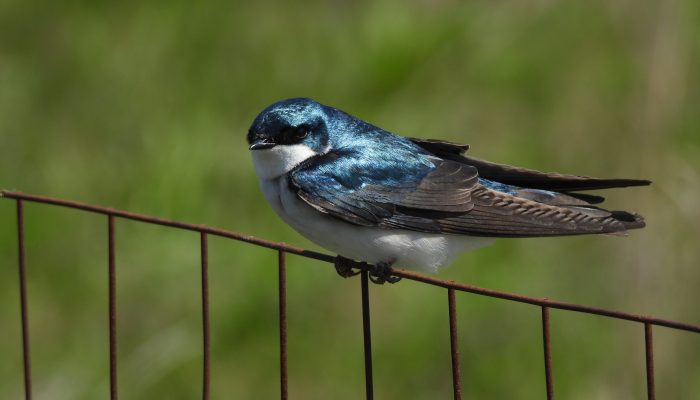What are they, why are they harmful, and how can you help control them?
The spotted lanternfly is an invasive insect. An “invasive” insect is a problematic bug that is not native to the United States. The spotted lanternfly is native to certain parts of Southeast Asia. Invasive species can spread quickly and are harmful to local plants and wildlife.
Lanternflies can destroy fruit trees, grapevines, and other agricultural crops. They also damage many forest trees. Though harmful to plants and a nuisance to people, lanternflies do not bite or harm people or animals.
Spotted lanternfly was first discovered in the United States in Berks County, Pennsylvania in 2014. Since then it spread throughout southeastern Pennsylvania and into surrounding states. In 2020, lanternflies become very prevalent in Philadelphia. People have found them in their yards, on street trees, and in parks. They have been found in very high numbers at some Parks & Rec sites, such as Wissahickon Valley Park.
What does a spotted lanternfly look like?

The image on the top left shows an adult that is displaying its red hind wings. You can see the insect’s red hind wings when it is startled, or when it flies. Most of the time, the adults sit with their wings folded over their backs (as shown in the image on the right, above).
What does the spotted lanternfly do?
The spotted lanternfly is a plant-hopper with piercing-sucking mouthparts. It inserts these mouthparts like a straw into a host plant. It then feeds on the sap flowing through the trunk, stems, and leaves.
This process damages and weakens the tree. Trees with high numbers of lanternflies feeding on them become stressed. This makes them more vulnerable to attack by other insects and diseases. Some trees have died as a result of a heavy infestation of spotted lanternflies.
Spotted lanternflies feed on more than 70 different types of plants. These include:
- Ailanthus (Tree of Heaven): preferred host species
- Grape
- Apple
- Maple
- Birch
- sycamore
- Willow
- Staghorn sumac
Females lay eggs in rows, starting in October, with 30-50 eggs per egg mass. One female may lay two egg masses before the end of the season.
What is being done about this?
In collaboration with the USDA, Parks & Rec is conducting treatments at a few locations in the city. This is helping us find ways to control the lanternflies in park areas.
Parks & Rec has removed most of the ailanthus trees (the insect’s preferred host) within these areas. Staff treated the remaining ailanthus with a systemic insecticide. The remaining “trap” trees attract the adult lanternflies. The lanternflies are then killed when they feed on the trees. Parks & Rec does not have the capacity to broaden the management of this pest.
What can you do to help?
- Treat trees with one of the insecticides approved to kill lanternflies.
- Trap them! You can kill a lot of lanternflies without using insecticides. There are several methods:
- Place sticky tape around the trunk of a tree.
- This will trap lanternfly nymphs (youth) while they walk up the tree trunk.
- Beware! Sticky tape can trap birds and beneficial insects.
- Penn State Extension has a short video that shows how to properly use sticky bands.
- Create a circle trap to catch the spotted lanternflies.
- A circle trap is basically a tunnel that lanternflies walk into.
- You make the tunnel using plastic-coated insect screening.
- Penn State Extension has created a handy guide on building a circle trap. Learn how to build a circle trap.
- Place sticky tape around the trunk of a tree.
-
- Lid-and-container. You can catch thousands of lanternflies with this way with practice.
- Fill a container with soapy water.
- Use the lid to get the lanternflies to leap inside.
- Lid-and-container. You can catch thousands of lanternflies with this way with practice.
-
- Smashing: kill nymphs and adults when you see them. Please note, lanternflies jump towards you, so plan accordingly.
- Scraping: scrape egg masses off of the trees into a container of rubbing alcohol.
Remember: the spotted lanternfly does not bite people.
Research is underway to determine how to best manage spotted lanternflies. This research may lead to other control methods.
How to identify and destroy spotted lanternfly eggs:
You can find spotted lanternfly egg masses from September to June.
- Lanternflies lay eggs in areas protected from wind and harsh winters, such as:
- The underside of a tree limb.
- The trunk of a tree.
- Any surface that is sheltered.
- Egg masses vary in size. They’re typically an inch long by 3/4 of an inch wide.
- The female secretes a white, waxy substance on the eggs to protect the mass.
- When dried, the egg masses they look like light grayish splotches of mud or cement.
- Each mass holds 30 to 50 eggs.
Use a credit card or putty knife to scrape the eggs off the tree into a container of rubbing alcohol or hand sanitizer. Or, smash the egg masses.
Some egg masses high up in a tree will be unreachable. This means you’ll still see lanternfly nymphs and adults next year…but every bit helps!

There is a quarantine order to try to contain this invasive insect. The order states that no one may willfully move any viable life stages of the lanternflies from within the quarantined area to outside. Residents should inspect any items for SLF or egg masses before moving those items outside the quarantined area. This is a simple but helpful way to avoid spreading the insects.
For the most up-to-date information on lanternfly research and control:
Explore the resources at Penn State Cooperative Extension, or,




